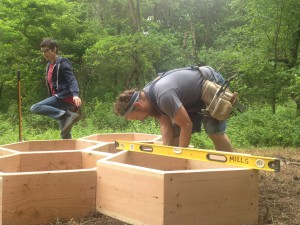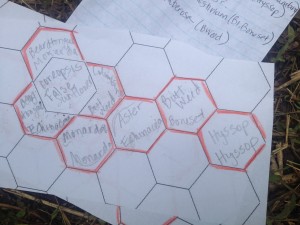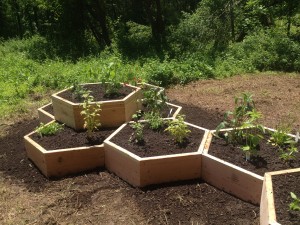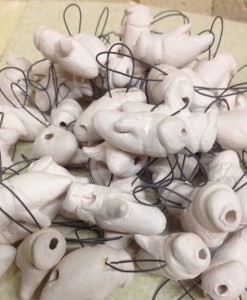By LandLab Resident Artists Maggie Mills, B.H. Mills, and Marguerita Hagan
Colony Collapse Disorder
The LandLab installation by Marguerita Hagan, B.H. Mills, and Maggie Mills addresses colony collapse disorder and the devastating global loss of honeybees. At present in the United States alone, 1/3 of the honeybee population has been lost to this disorder. These mini, mighty pollinators make every third bite of food we take possible. Ironically, it is human behavior that is responsible for the honeybees’ catastrophic disappearance. Our installation provides a chemical free, native pollinator garden for the bee population on the grounds of the Schuylkill Center. We will be spreading the word about ways that we all can contribute to positive, sustainable, and mutually beneficial outcomes through education and community partnering in the coming months.
 Honeycomb Engineering
Honeycomb Engineering
Down the Schuylkill Center’s Widener Trail, the Bird Blind has a new neighbor that attracts a different kind of winged creature. We have installed hand crafted, chemical-free, Douglas fir raised beds containing organic soil and native, bee-friendly plants. These hexagonal beds reflect the genius of the honeybees’ engineering.
 Native Plants
Native Plants
The plant names in this LandLab installation are as diverse as their color, texture, succession of bloom, and form: beardtongue, bee balm, New England aster, eastern columbine, purple giant hyssop, coneflower, butterfly weed, false sunflower, and blue mistflower. A relief etching labeled with both common and scientific names will identify each of these species. Now taking root, the beautiful flora offers visual joy to passers-by on foot and healthy forage to those on wing; the pollinators are in dire need of their service.
 Bee Data Tracking
Bee Data Tracking
The resident bee population at the Schuylkill Center has not been spared the recent decline. We are poised to track pollinator activity in the native garden with our team, community members, and summer campers participating in the project. We will work with the both student and adult visitors to the Schuylkill Center to provide instruction on colony collapse disorder, identification of pollinators, and gathering data daily.
 Bee Making
Bee Making
We will have “Clay Bees” in the spirit of Quilting Bees to expand the clay bee population. Youth, staff, and community members can get involved with this aspect of this project on Saturday, June 14: making clay bees for installation on-site with the pollinator garden. Thousands of bees will be made and in the process, participants will learn about options for remediation of colony collapse disorder. Once we have a healthy hive of bees made in clay, the bead-like bees will go through two firings in the kiln.
 Pit Fire
Pit Fire
The ceramic bees will then be ready to be dramatically painted by the fumes and flames of a primitive outdoor firing or pit firing. The annual Great American Backyard Campout on Saturday, June 28 is the perfect way to fire the new clay bee population while gathering together for some fun around the campfire. We will rest the bees in a bed of sawdust over which the fire will be laid. The following morning a treasure hunt will ensue, uncovering the bees with care from the cool ashes. Once washed and sorted they can be installed swarming alongside the native bee-friendly garden.
About the Authors:
B.H. Mills is a master carpenter, sculptor, and organic gardener. He has been working in wood, concrete, and other sustainable and reclaimed materials for twenty years. He is currently installing a sculpture garden on 1.5 acres of his home property.
Maggie Mills is a painter, teacher, and organic gardener. Her work addresses the effects that environmental and political dynamics have on our contemporary spaces and the legacy that we leave to subsequent generations through these spaces.
Marguerita Hagan celebrates what John Muir understood: When we pick out anything, we find it hitched to everything else in the universe – in process, sculpture, teaching and community arts collaborations. Cultivating potential and solutions with each sculpture, student and project she leads while serving hundreds with 30 years in clay and sustainable action.
